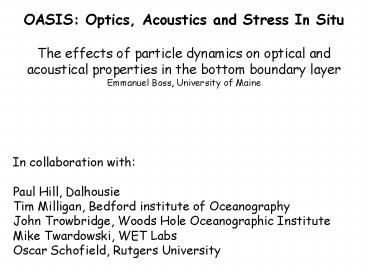OASIS: Optics, Acoustics and Stress In Situ PowerPoint PPT Presentation
1 / 15
Title: OASIS: Optics, Acoustics and Stress In Situ
1
OASIS Optics, Acoustics and Stress In Situ The
effects of particle dynamics on optical and
acoustical properties in the bottom boundary
layer Emmanuel Boss, University of Maine In
collaboration with Paul Hill, Dalhousie Tim
Milligan, Bedford institute of Oceanography John
Trowbridge, Woods Hole Oceanographic
Institute Mike Twardowski, WET Labs Oscar
Schofield, Rutgers University
2
A Larger Program
WATER COLUMN Properties
OASIS
Comm. Sed. Model
Physical Forcing
Models
SEABED Properties
Ripples DRI
3
Objective link ocean biogeochemistry to its
optical and acoustical properties. Forward
problem How are optical and acoustical
properties (scattering, attenuation) affected by
the properties (concentration, composition, size,
shape) of oceanic particles ? Inverse
problem How can we use optical and acoustical
measurements to learn about the properties of the
underlying particles ?
4
Navy relevance Develop predictive capabilities
able to provide time scales it would take water
to clarify following a resuspension event (e.g.
for optical/acoustical systems and
diver). Suspended sediment transport and
settling (e.g. object burial). Interpretation of
remotely sensed signal in coastal environments
(e.g. bottom type, depth, suspended particulate
composition).
5
Conceptual model linking particles and dynamics
in BBL
6
Aggregation in the marine environment Aggregatio
n is a concentration2 phenomena. Mechanisms
for encounter Brownian motion, differential
settling, and turbulent shear. Aggregate sink
faster than their component particles. Aggregates
break when shear is too high.
Camera pictures at 1mab at a 12m deep site within
1day
Dominated by lt100um particles
Dominated by gt1000um particles
7
- Past work has shown that
- Size distribution characteristics are correlated
with concentration in BBLs. - Vertical distribution of optical properties as
function of depth from bottom is inconsistent
with what we expect.
Why?
- Hypothesis aggregation dynamics.
- Aggregate formation is concentration2 phenomena
? removes fast excess particles (transient)
leaving behind a stranded population with a given
particulate size distributon. - Aggregates sink fast and break close to the
sediment-water interface where the resupply the
water with small particles resulting in high
gradient.
8
Direct evidence for aggregation effects on
optics Particle size distribution as seen by two
LISST-B.
Destruction of large flocs
Production of smaller particles
Control both instruments deployed with the same
configuration
Experiment One LISST Pumped (red) and the other
not (blue)
9
Direct evidence for aggregation effects on the
optical attenuation coefficient
Beam attenuation increases by 25 when we break
the aggregates.
10
Aggregate modeling can help explain these
observation
Latimer (1985)
2
4mm
For marine aggregates size and solid fraction
correlate.
-points having size-F as in Maggi, 2007
11
- In addition upper bound on contributing
particles depends on - Their concentration in the sample (spikes vs.
continuum). - The acceptance angle of the instrument
12
Observations from many coastal areas suggest that
cp/mass is rather constant
Babin et al., LO 2003
Alliance of Coastal Technologys data set
0.5m2/g
Such relative insensitivity to size distribution
can be explained by aggregation
0.25m2/g
13
- Why acoustics?
- Acoustic scattering is due to change in sound
speed. Different sensitivity to composition than
optics. - In the MHz range, most sensitive to particles
that are O(100mm) where optics (other than
imaging) is not sensitive or is affected by
turbulence. - Less prone to bio-fouling.
- Suspended sediment acoustics is a mature field
(ONR-related scientists Thorne, Hay). - If measured with current meters ? provides
turbulent flux of particles, important input to
sediment modeling.
14
Comparison of acoustical and optical
backscattering
R20.86
Day 246, 2005
R20.42
Day 250, 2005
15
Other contributions from this work 1. Building
of an optical module relating sediment mass,
size class and optical properties to be available
for the community sediment transport model. 2.
Establish when and with what wavelengths can size
information be inferred from spectral
backscattering (measured from AUVs and
gliders). 3. First commercial acoustic
attenuation sensor (modified MAVS).

